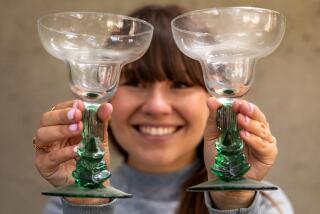Sotheby’s Cyber Sales Adventure
- Share via
Real artworks or fakes? Legitimate bidders or shills? Lots of cpquestions about the perils of online art auctions have been raised by the recent scandal at EBay involving a painting that may or may not be the work of the late Richard Diebenkorn, offered by a seller who was later suspended from the site for placing bids on his own consignment.
But there’s another world of online art auctions, and it’s quietly gaining a toehold in the market. Unlike EBay’s consumer-to-consumer system--in which merchandise is put up for sale with no guarantees of authenticity--a batch of other auction sites offers art and antiques vetted by specialists.
The leader of the fledgling business is sothebys.com, launched early this year with a $42-million investment by Sotheby’s New York auction house. After five months of operation, the site--which brings in about $1 million in sales each week--already sells the lion’s share of authenticated fine and decorative art, jewelry and rare books offered in online auctions. And that is only the beginning of the firm’s aggressive Internet initiative.
Consider two events scheduled this week at Sotheby’s showroom in Beverly Hills. One is an exhibition of an original copy of the Declaration of Independence, Thursday through Saturday, 10 a.m.-4 p.m. The rare document--one of two dozen copies known to exist and one of only four in private hands--was discovered in 1989, tucked into the backing of a tattered painting sold for $4 at a flea market. The manuscript brought $2.4 million at auction in 1991, and now it’s going on the block again, at an estimated price of $4 million to $6 million. But it won’t be the star of a live New York auction, as might be expected. The sale will be conducted at sothebys.com on June 29, 9 a.m. to 5 p.m. EDT.
“This is a serious business decision, not a curiosity,” Craig Moffett, president of sothebys.com, said of the plan to offer the Declaration of Independence online instead of at a bricks-and-mortar establishment with a flesh-and-blood auctioneer drumming up excitement and coaxing bids from collectors.
Proclaiming the upcoming sale “a milestone,” David Redden, the firm’s executive vice president, said the auction will prove that the Internet “has arrived as a venue for selling important property.”
In sharp contrast to that sale, the second local event--an Heirloom Discovery Day on Saturday at the Wilshire gallery--is geared to much smaller pocketbooks and a broad audience.
“Clean out your attic and clean up online,” says a press release inviting the public to bring artworks and other objects to Sotheby’s for free appraisals. Unlike at past Heirloom Discovery Days, Sotheby’s will encourage those who wish to sell their heirlooms to do it in cyberspace: fine art, antiques, jewelry and rare books on sothebys.com; less valuable collectibles via sothebys.amazon.com, a joint auction site created last November by an alliance with Amazon.com.
Both the Declaration of Independence exhibition and the Heirloom Discovery Day will probably bring a new level of visibility to a sector of the art and antiques market that has been shaping up on computer screens over the past couple of years. While hundreds of Internet sites offer art for sale, there are relatively few online auctions of vetted art and antiques.
Artnet.com--an online database and marketplace, which was founded in 1989 and claims to be “the premier Internet site for art information and E-commerce worldwide”--began its auction program in March 1999. Butterfields auction house merged with EBay last year and now vets material for EBay Great Collections, an online auction program that began last October. Sotheby’s first electronic gavel fell on Jan. 25. Christie’s, Sotheby’s major competitor in live auctions, does not conduct auctions on the Internet but plans to add online bidding to its client services.
“This is still a pretty nascent market,” said Moffett, who joined sothebys.com in December. Acknowledging the difficulty of compiling meaningful data on the fledgling business, he estimated that his company has captured 75% to 80% of the online art auction market. Artnet.com--probably Sotheby’s closest online competitor--sold $2.3 million worth of art in auctions during its first year. Sothebys.com passed that mark during its first three weeks of operation. Additionally, during its first 100 days of operation, sothebys.com registered more than 40,000 bidders, at least half of whom were new to the auction house.
*
Still, online art auctions haven’t even begun to make a dent in the live auction business. Dealers say most of their Internet sales--if any--are at the low end of the market. At sothebys.com, the average sale is $1,500, compared to $14,000 at Sotheby’s live auctions.
The disparity in record prices is even more extreme. The top sum paid for an artwork in a live auction is $82.5 million, for Vincent van Gogh’s painting “Portrait of Dr. Gachet,” at Christie’s New York in 1990. The most expensive work of art purchased in an online auction is $168,000, for a watercolor by Italian contemporary artist Luciano Fontana, sold last year by artnet.com. Next on artnet.com’s list of top sellers is a drawing by Robert Longo, which was sold for $36,750--less than a quarter of the Fontana price.
At sothebys.com, the highest price paid so far is $88,000, for a 1518 book on hunting and fishing. The most expensive artworks sold on the site are a watercolor by German Expressionist Ernst Kirchner ($60,500), a portrait by American painter Jasper F. Cropsey ($57,200) and photographer Ansel Adams’ well-known image “Moonrise, Hernandez New Mexico” ($31,900).
No one claims to have a complete grasp of what sells and what doesn’t in the still-evolving world of online art auctions, but the Internet offers some advantages to sellers. One is a global audience. Los Angeles photography dealer Stephen White, who sold 10 of the 24 pieces he consigned to the first sothebys.com auction, said the buyers live in Germany, Hong Kong, England, Canada, Puerto Rico and Washington, D.C. “The international aspect is amazing. I would never have found those people on my own,” he said. And although his experience on subsequent auctions has been relatively disappointing, he plans to stay in the game.
Another reason to sell an artwork on the Internet is timing, said Stephen Turner, director of appraisals and Internet services at EBay Great Collections. A seller who doesn’t want to wait several months for an appropriate live auction can place an artwork online relatively quickly.
Most online art auctions run for two weeks, with sales organized in traditional categories according to historical period, geographic region, art form or subject matter. But theme sales--Picasso ceramics, images of mothers and their children, or American regionalism--seem to be more popular, so sothebys.com is moving in that direction. “@ The Artists’ Studios,” an auction of works by 20 young artists offered by P.P.O.W. Gallery in New York, will begin Thursday and run through June 24. A sale of Pop art, featuring prints by Andy Warhol and Roy Lichtenstein, is scheduled for June 13-28.
The EBay controversy might be expected to cast a pall over business, but Moffett discounted that possibility. “EBay is in the classified ad business; it doesn’t vet pieces. We really don’t compete with them,” he said. Furthermore, the Diebenkorn debacle actually helps his company because it reinforces the fact that “buyer beware is not a wise strategy,” he said.
Sotheby’s has its own problems with an ongoing federal investigation of charges that the company colluded with Christie’s in a price-fixing scheme. But Moffett also contended that the in-house scandal has had little impact on the Internet initiative.
His major challenges, he said, are to bring in a steady stream of attractive material and to build confidence in a new way of marketing art. Sotheby’s is a 256-year-old company, but the Internet has none of the trappings of traditional institutions. “Buying art is inherently a transaction that requires trust,” he said.
More to Read
The biggest entertainment stories
Get our big stories about Hollywood, film, television, music, arts, culture and more right in your inbox as soon as they publish.
You may occasionally receive promotional content from the Los Angeles Times.










